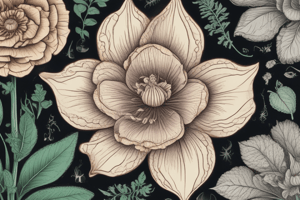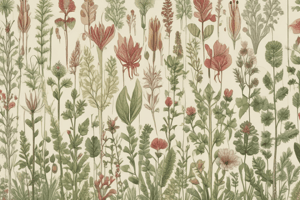Podcast
Questions and Answers
What type of plants have vascular tissue?
What type of plants have vascular tissue?
Lycophytes and Pteridophytes, Gymnosperms, Angiosperms
Which plant group produces 'naked seeds' or cones?
Which plant group produces 'naked seeds' or cones?
Gymnosperms
What type of plants have leaves that are lost during the fall?
What type of plants have leaves that are lost during the fall?
Angiosperms
Which plant group has a reproductive structure called 'flowers'?
Which plant group has a reproductive structure called 'flowers'?
What type of plants grow low to the ground and require high moisture in the soil?
What type of plants grow low to the ground and require high moisture in the soil?
Which plant group lacks vascular tissue?
Which plant group lacks vascular tissue?
What are the 3 primary (non-reproductive) organs of a plant?
What are the 3 primary (non-reproductive) organs of a plant?
What are the 2 organ systems in plants and what do they do?
What are the 2 organ systems in plants and what do they do?
What are the 4 layers of plant tissue and their functions?
What are the 4 layers of plant tissue and their functions?
What is the function of xylem in plants?
What is the function of xylem in plants?
What is the role of phloem in plants?
What is the role of phloem in plants?
What is the significance of meristematic tissue in plants?
What is the significance of meristematic tissue in plants?
Study Notes
Types of Plants
- Vascular plants, such as tracheophytes, have vascular tissue that allows for transportation of water and nutrients.
- Gymnosperms, such as conifers and cycads, produce 'naked seeds' or cones.
- Deciduous plants, such as oak and maple trees, have leaves that are lost during the fall.
- Angiosperms, such as flowering plants, have a reproductive structure called 'flowers'.
Plant Characteristics
- Bryophytes, such as mosses and liverworts, grow low to the ground and require high moisture in the soil.
- Non-vascular plants, such as bryophytes and algae, lack vascular tissue.
Plant Organs and Systems
- The 3 primary (non-reproductive) organs of a plant are roots, stems, and leaves.
- The 2 organ systems in plants are the root system and the shoot system, which are responsible for absorption and transportation of water and nutrients, and photosynthesis and growth, respectively.
Plant Tissue
- The 4 layers of plant tissue are epidermis, cortex, sclerenchyma, and parenchyma, which provide protection, storage, support, and photosynthesis respectively.
Plant Functions
- Xylem tissue is responsible for transporting water and minerals from roots to leaves.
- Phloem tissue is responsible for transporting sugars and nutrients produced by photosynthesis from leaves to the rest of the plant.
- Meristematic tissue is responsible for plant growth and development, as it has the ability to differentiate into different cell types.
Studying That Suits You
Use AI to generate personalized quizzes and flashcards to suit your learning preferences.
Description
Test your knowledge on plant anatomy by taking this quiz on plant organs, organ systems, and tissues. Learn about the primary non-reproductive organs, organ systems for water transport and energy storage, and the layers of plant tissues.




